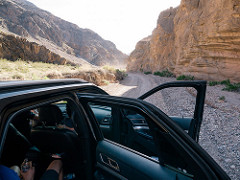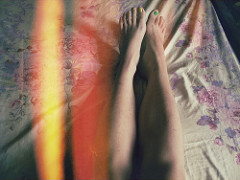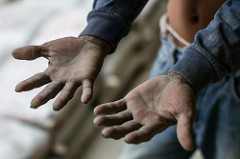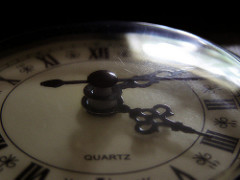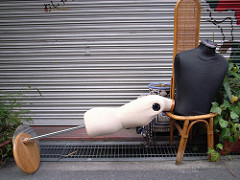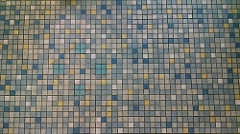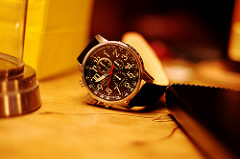There were four of us, following a dirt road which began
in the foothills and went right up into the mountains
where a little cottage was waiting for us.
Issue 04
The Other One
By NADINE BOTHA
I could find a million nuances for how to improve me and influence my life,
as though, if I could just identify that one—like The One, the love—
I would know, it would know and that would be that.
Writer
I keep my tools
hidden,
until the sun rasps
its black breath over
the suburbs. Only then
The Body
the Body rearranges
itself around
the other. points of entry and exit,
embraces. Embraces. the
thrill of skin. density
surrenders to Liquid. semen, blood,
mucous, milk. the Body yields to
Suspension
from Invisible Earthquake
1st May, 12h38
I’m navigating in and out
Of mental combat
Trying to figure
Exactly what station I’ve pulled into,
How to answer that simple question
How are you?
Enough of an Interruption
By ALAN FINLAY
It’s our wedding anniversary—i almost forgot.
been drowning listening to bartók,
and when i say
drowning i mean—
you run bathwater
submerge yourself, exhausted
“ask daddy”
What I Should Have Worn at My Wedding
By LIESL JOBSON
Potato skins, not peach skin satin,
pills, not pearls for buttons at my wrists,
onions in my bouquet, for coming tears.
12 Anxieties for April 12th
By LIESL JOBSON
On my side of the glass
POLICEMAN KILLS CAT
are burglar bars
on the other side
“DR DEATH” ACQUITTED
a grille
The Common Statement
From The 17th Floor: First Impressions
These days, you arrive in a new place from a great height. Brief glimpse
of patterned land, sometimes sea, then trundling along skyways until
finding your way down to the ground and the transport available there. Eventually, you make your way to the heart of the place, where you can approach it from eye level.
It is clear, the night we arrive, cruising along the gleaming highway under bright signs in Arabic and English, that we are driving toward the center. We pass The Petroleum Institute, the Ministries Complex, and, just before the lights all around brighten into city life, an expanse of scrub where the dark is very deep. Beyond the sabkha, the salt flats, likely water; Abu Dhabi is a grouping of islands adhering to a curve of land at the ankle of the Arabian Peninsula on the Arabian Gulf. The traffic thickens—as does the cologne of our cab driver, sprayed now in quick pumps in rhythm to the Dubai-based reggae station—and the roadsigns begin to display the names of sheikhs. People and sidewalks materialize. No street vendors, no one begging—this is a city in development, but it is not the developing world. It feels like a hub. It will be, at least, our hub for the next year, this year of teaching abroad. Practicing restraint, I do not reach for my husband next to me, knowing public affection is frowned upon. Stalled at a long light, I stare straight ahead and will us forward.
I am confirmed in my belief that we are at the heart of things by the view from my office window on the 13th floor. I look down on Qasr al Hosn, the oldest stone building in Abu Dhabi. Built in 1761 as a watchtower guarding the area’s only freshwater well, it became a sturdy fort as well as the ruling sheikh’s palace until 1966. Now the whitewashed towers rising above the window-dotted walls glow strangely quiet. Adjacent is the Cultural Foundation, along whose smooth, beige walls are long rows of unadorned Moorish arches, boring in comparison to the sculpted arches and blue stained glass windows of the mosque below our apartment window. Wedged between a parking lot, a hospital, and a block of electronics and garment shops, its buttery walls, central dome, and two elegant minarets rise and warm in the summer sun.
Our apartment, above the offices, is on the 17th floor. Not such a great height for people who have lived in cities, but high for me, used to an old boot factory in western Massachusetts or a Brooklyn brownstone, where I could hear, and sometimes see, the greetings of dog walkers and amorous couples across the street. In the country, shockingly loud birds wake me; in Brooklyn, street cleaning and delivery trucks. Here, the only sound that breaks through the air-conditioned hum is the call to prayer from the muezzin, broadcast via satellite from the Grand Mosque. The gorgeous, mournful adhan initiates a slow-paced gathering of men in robes who slip off their shoes then cross the threshold into prayer.
Most days, despite temperatures well over 100 and humidity reaching seventy-five percent, I am compelled down to the street. It is not enough to be up high, to observe from afar; I want a part of it, whatever it is, down below. You can’t live your life from the 17th floor.
“Thank God for the street!” Vivian Gornick writes in her classic New York City essay “On the Street.” “Those of us who crave the expressive but can’t shake off the melancholy walk the street. The pavements of New York are filled with people escaping the prison sentence of personal history into the promise of an open destiny.”
The sweetness of that destiny lies in Gornick’s sidewalk and shop-doorway contact with strangers, the improvisational theater sparked by being both visible and observed, both performer and audience; the jazz of strangers’ closeness, including the “impersonal affection” of an apologetic hand.
The city’s minute street-level upheavals and entertainments are integral to Gornick’s own personal life force.
“There are mornings I awake and, somehow, I have more of myself. I swing my legs over the side of the bed, draw up the blind, and, from my 16th floor window, feel the city filling itself across my eyes, crowding up into the world, filling the landscape. Behind it, there in the distance, where it belongs, is the Hudson River and, if I want it, the sky. But I don’t want it. What I want is to take this self I now have more of down into those noisy, dirty, dangerous streets and make my way from one end of Manhattan to the other in the midst of the crowd that also may have more of itself.”
The vibrancy and intensity Gornick lives for is created by what Danish architect and urban design consultant Jan Gehl calls “the people scale.” The author of such modestly titled books as Cities for People and Life between Buildings, Gehl has built a forty-year career around his concern for individuals’ urban happiness. Life-affirming person-to-person contact occurs, he says, in cozy spaces of dimensions apprehensible by the human body: sidewalks wide enough for walking; plazas with shade and comfortable benches; eye-catching architectural details and amenities on the ground floor; buildings of not more than five stories. Perhaps most important is minimal exposure to cars, whose size, noise, pollution, and need for large spaces and high speeds skews the scale and edges people out. The explosion of automobile use and the dominance of the stark lines and angles of modernist architecture, Gehl argues, have conspired to worsen quality of life for urban dwellers in many mid-century American cities as well as in rapidly expanding cities in Asia, Latin America, and all over the world.
Downtown Abu Dhabi, on Abu Dhabi Island, one of the larger land masses clustered along the mainland, dates from the first decades of nationhood after the United Arab Emirates was formed in 1971. Imposed harshly on this desertscape is a grid of massive superblocks sliced up by massively wide streets—four lanes in each direction—divided by palty strips of tough grass and a few trees. At the intersection just below my office window is a small blue and yellow fountain shaped like an opening flower. But kept company by no benches and comforted by no shade, it’s just another fixture to drive by.
At the perimeter of the wide streets are thick rows of square buildings between fifteen and twenty stories tall. They stand stiff shouldered apart from each other in the haze, their façades flat—“rushing like a Norwegian fjord down to the street with no mitigation,” Gehl would say—and shellacked with tinted windows, the stone or concrete in dull desert hues. They’re not attractive, yet nor do they offend. At night, above the shops at street level, the windows are dark. Employees of Abu Dhabi private enterprises supposedly keep long hours, but in these buildings either no one is working late or no one is living.
Not yet anyway. In Abu Dhabi self-definition lives in the future tense. About the city’s oldest district—the heart of the shore’s fishing and pearling history—the 2011 Explorer guidebook reads, “the new Al Bateen Wharf will be a total facelift and include a fisherman’s village, with a 400 room twin tower hotel, a boardwalk flanked by cafes and restaurants, and a marina complex. . . . It will also have health clubs, spa facilities, a business centre and a range of apartments.”
From the 46th floor, where I run on the treadmills poised before what will be a far-reaching view in drier weather, I survey the development all around and realize that I am hovering over a map. Far below, the cars and roads flatten into a unified stream of blurred gray; beyond several rows of superblocks is the sea blotched with islands. In my mind, body still treading on the moving sidewalk, I match the view to the map spread out on our living room floor, a map whose districts and landmarks are annotated with “(proposed)” and “u/c” for under construction.
In 2007, the government published Plan Abu Dhabi 2030, a 175-page illustrated document envisioning how the city can and should change to meet the needs of a rapidly expanding population (from roughly three-quarters of a million—calculations vary—in 2012 to an expected three to five million twenty years from now) and the reality of finite oil reserves. The plan outlines the development of several important districts, such as the Central Business District (encompassing the area we live in now), the Capital District, the Grand Mosque District, and several others emphasizing different industries and marked for more or less business, touristic/recreational, and residential use.
I am not an architect nor an urban planner, nor, obviously, an experienced resident. I can speak only to initial impressions. As a recent arrival, amateur fan of Gehl, and ardent walker, what spikes my excitement and optimism about this place are not the hard-to-visualize grandeur of future cultural, religious, and retail centers, but the retrofitting planned for the city that currently exists. By 2030, the plan says, parks and business centers will be linked not only by metro and light rail but also by “planted boulevards and byways” that enable people to “traverse the city under the cover of shade trees and reinforce the vision of the city as a garden on the shores of the Gulf. In this way all streets, especially local streets, can be seen and used as public open space, not just as traffic routes.” Other sentences that advocate moving parking lots underground and widening sidewalks relieve me of the heat-and-blacktop-driven anxiety that takes over when I stand isolated on a wedge of concrete waiting for the green walk signal.
While I wait, I look around at the people: single men from Southeast Asia (Pakistan, India, Bangladesh, the Philippines, Malaysia) in various work uniforms—blue construction coveralls, white taxi-driver longsleeves, polos with private company logos; Arabian men in their enviably white and loose dishdashas; a handful of women, draped in saris or abayahs, some clad in jeans, nurse uniforms, and the occasional pantsuit. As much as I thrill to this diversity, the gulf views, the muezzin’s call, and the scents drifting from perfume shops—to the thrum of a city in the midst of inventing itself—it’s hard to imagine an electric street culture such as Gornick evokes. Perhaps come October and cooler weather, perhaps come five or ten years from now when the population of male guest workers solidifies into couples and families, perhaps then the sidewalks will fill and rumble with voices and impromptu scenes—if not the carefree rubbing of elbows among strangers.
The jostling streetwalkers of Gornick’s days come back to haunt her at night. Over dinner, they justify themselves, jabbering and expanding. They are great company. “They return the narrative impulse to me. Let me make sense of things. Remind me to tell the story I cannot make my life tell.” Without life in the street, I’m not yet sure what stories I can tell. At the beginning at least, they will be heady speculation, as seen from above.
In a week of daily observance, the buses parked near the Qasr al Hosn have not moved. The dust hasn’t stirred. I haven’t seen a single body cross the site, and I realize that the makeshift construction border ringing the old stone fort and the Cultural Foundation is uninterrupted. It’s closed now, unvisitable. Except for me: I can enter from above any time, walk the cool dim interior halls, window light patterning the floors, the loose clothing of imagined strangers whispering along, keeping me company.
—Jennifer Acker, Editor
Abu Dhabi, United Arab Emirates
Jennifer Acker is the founding editor of The Common.
Escapement
Selkirk had never owned a wristwatch. It had never seemed necessary to be in possession of one. What time it was had never been of any consequence to him in any part of his life. There was his childhood in Calcutta when time seemed lozenge-like, lickable—those long afternoons of lying still in shaded rooms, and then afternoon tea on the veranda with his mother, tapping out with her long nails the anguish of her most recent rebuff at one of the clubs on account of her lowly origins—and then, mercifully, his father, returning from a long day at work, the gentle grey-haired man who had rashly married this chorus girl in the throes of middle age, his father, still loyally serving the company he had joined as a young man in pre-Independence times and trying to make as good a life as possible for them all. When he unexpectedly keeled over, just a few months before he was due to retire, she did not hesitate to return to her old life, and Selkirk was promptly despatched to the boarding school that his father had attended, where time—to return to our original subject—was dispensed in quantities he could neither measure nor understand.
